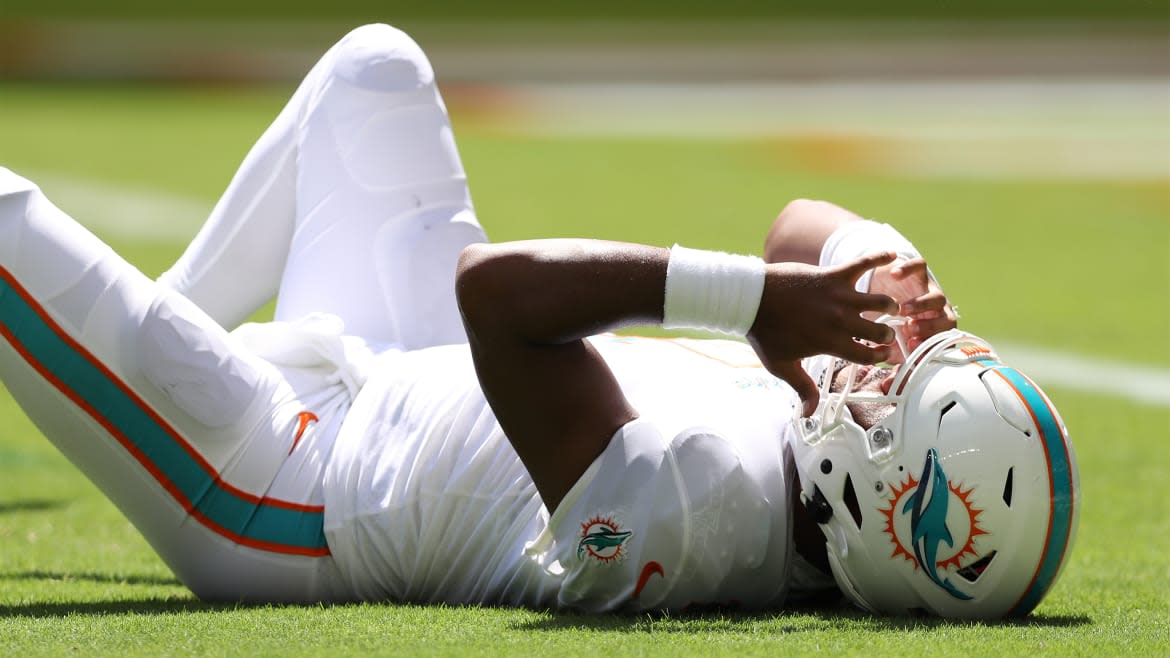I Diagnosed Brain Injuries on the NFL Sideline. The New Concussion Rules Have a Glaring Hole.

As Americans dived deeper into another football season and the media frenzy around the Tua Tagovailoa injury fiasco began to fade into the background, the NFL and its players union on Sunday implemented changes to their much-scrutinized concussion protocol. Specifically, as the New York Times reported, players who show signs of ataxia—balance and coordination issues that may be caused by brain or nerve damage—cannot return to games, no matter what team doctors or coaches believe about the source of the problem.
What this effectively means is that no player who has lost control of their limbs can continue playing, as Tagovailoa was permitted to after collapsing in a recent Bills game, with the disturbing episode attributed at the time to a back injury.
But if this is a welcome modification and clearly in the interest of player safety, it also falls firmly into the category of “well, duh!”
I am a neurosurgeon who served as an unaffiliated neurotrauma consultant on the sidelines of NFL games for four football seasons, from 2015-2018. When I was on the sidelines, assessments consisted of components of a physical exam and questions designed to assess mental status; for example, tasks assessing memory, concentration, and the ability to calculate.
The challenge with these assessments is that there is tremendous variability in baseline function from one player to the next. And some players even try to “game the system.” As Peyton Manning told ESPN years ago, “They have these new [brain] tests we have to take before the season…. Then, after a concussion, you take the same test and if you do worse than you did on the first test, you can’t play. So I just try to do badly on the first test.” More recently, former Chiefs quarterback Alex Smith described a similar successful effort at gaming the tests.
Fox News Host Dagen McDowell Dismisses Tua Tagovailoa’s First Head Injury as ‘Lunacy’
The challenge with assessing brain injury is not unique to the NFL. Measurement of brain injury and concussion in the general population is even more tricky because there is additional variability introduced by different languages, cultures, education levels, alcohol, drugs or medications, and other conditions that may impact a person’s ability to perform a mental status test. Other problems such as hunger, fatigue, and distraction can make an assessment difficult to standardize. Partly as a result of this, outcomes after brain injury are much worse in certain patient populations, such as people of color.
Because of this difficulty in assessing brain injury, a concussion diagnostic would ideally rely on assessment of functions that are not volitional—things that are essentially brain “reflexes.” This is where a technology—like the one I have developed with colleagues in the private sector—that performs a digital neurological examination of primitive brain functions can be useful.
But there are obvious barriers to incorporation of a new diagnostic—most particularly from the NFL and its players.
The NFL’s interest is, of course, in maintaining their grip on American attention. That grip relies on the compelling drama of its players moving the ball at the peril of life and limb. While NFL Chief Medical Officer Allen Sills and his team has launched a laudable effort to reduce most injuries, ultimately the players are what sells the game, and taking them out only damages it. I would expect the NFL to keep its focus, as it has in the past, on prevention of injury via rule changes, and turf or helmet modification based on interpretation of accelerometer data to reduce impact forces, rather than looking at improved diagnostics for brain injury. That is, the NFL will do everything that it can do to make the game safer while preserving its essential nature and reducing its own legal and public relations risk.
Improved diagnostics for brain injury are probably going to be perceived by at least some lawyers as ultimately increasing that risk.
The National Football League Players Association’s (NFLPA) interest, meanwhile, is in enabling its players to achieve career goals unavailable to the meeker and weaker masses. In a Faustian exchange for their health, they have an earning capacity beyond most people’s wildest dreams, public adulation, and the opportunity to live for the sheer joy of sport. The players know the risks of the game just as a boxer knows the risks of the ring and a skydiver challenges gravity. Yet they choose to play. Avoiding the appearance of injury is critical to every aspect of their dream, and objective measures for injury could only derail that. At the end of the day, if they can hide their injury, they often will, as it is in their strong personal interest to do so.
Which is to say I fear that some players will only seek improved diagnostics for brain injury after their careers have ended.
But the reality is that objective measures of neurologic function do exist, and the NFL and NFLPA will ultimately have to accept that fact. The brain’s reflexive functions—the pupil’s response to light, the coordination of eye movements, and blinking—tell us how well the brain is working, or if it is not working. This kind of digital neurologic examination is already in use at hospitals and clinics throughout the country, where it enables more equitable care.
Is the incorporation of objective measures for brain injury the future of sport? I think so, but that this will likely happen at the youth and amateur levels before the NFL.
Once it trickles up, there is at least some hope for the prevention of future fiascos like that of Tagovailoa.
Get the Daily Beast's biggest scoops and scandals delivered right to your inbox. Sign up now.
Stay informed and gain unlimited access to the Daily Beast's unmatched reporting. Subscribe now.

